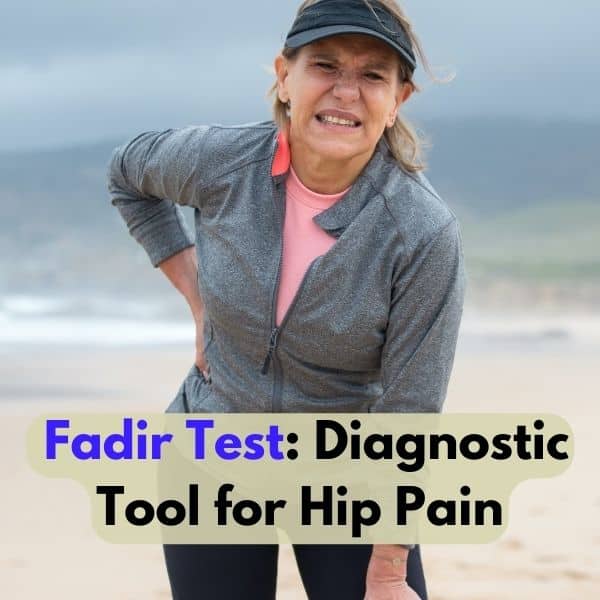Hip pain is a common complaint, particularly among athletes and participants in high-impact activities. Conditions such as labral tears, femoroacetabular impingement (FAI), and hip joint osteoarthritis can all cause it. The FADIR test is a diagnostic tool used to evaluate hip joint pain and dysfunction.

What is Fadir Test
The FADIR test, also known as the Anterior Apprehension Test or Flexion-Adduction-Internal Rotation test, is a non-invasive diagnostic that consists of flexing the affected hip to 90 degrees, then adducting and internally rotating the hip, compressing the hip joint. It is a clinical assessment used to examine people who have hip pain and suspected femoroacetabular impingement (FAI).
How to Perform Fadir Test
The test involves extending the hip to 90 degrees, then adducting and internally rotating the hip, which can simulate pain and symptoms in FAI patients.
The healthcare professional applies a downward force to the flexed knee while the hip is adducted and internally rotated during the FADIR test. This movement may indicate the presence of FAI if it reproduces the individual’s pain or provides a clicking sensation.
If the individual feels discomfort in the hip when moving, the test is considered positive.
Fadir Test Hip
The FADIR test is an effective diagnostic tool for determining hip joint pain and dysfunction. It is frequently used in sports medicine and physical therapy to assess athletes who have hip pain.
Fadir Test Positive
A positive FADIR test result indicates that there is a problem with the hip joint, and more diagnostic tests, such as imaging examinations, may be needed to confirm the diagnosis.
Faber and Fadir Test
Both the Faber and FADIR tests are diagnostic procedures used to evaluate hip joint pain and dysfunction. They differ, however, in the position and movement of the hip joint during the test. The Faber test includes flexing, abducting, and externally rotating the hip, whereas the FADIR test includes flexing, adducting, and internally rotating the hip. Both tests can help with the early detection and diagnosis of hip joint disorders, and a healthcare practitioner can decide which one is best for each specific situation.
(Read More: Ottawa Ankle Rules)
Conditions Diagnosed Using the FADIR Test
Labral Tears
The hip joint is a ball and socket joint surrounded by a cartilage ring called the labrum. Labral tears can arise as a result of a traumatic event, repeated action, or degenerative changes. Hip pain, clicking, locking, or catching during movement are all symptoms of labral tears.
Femoroacetabular Impingement (FAI)
FAI is a condition in which the hip socket and the ball of the hip joint make abnormal contact. It can happen as a result of irregular hip joint anatomy, repetitive movements, or trauma. FAI symptoms include hip pain, stiffness, and a restricted range of motion.
Hip Joint Osteoarthritis
Osteoarthritis is a degenerative joint condition that damages the joint cartilage and bone. It can occur as a result of aging, trauma, or improper joint mechanics. Symptoms of hip joint osteoarthritis include hip pain, stiffness, and decreased range of motion.
Benefits of Early Detection
Early diagnosis of diseases like labral tears, FAI, or hip joint osteoarthritis can be helpful in a variety of ways. Firstly, it allows for prompt treatment, which may prevent the progression of the condition and further complications. Early diagnosis and treatment can also help people better manage their pain and discomfort, resulting in a higher quality of life.
Furthermore, early detection of these illnesses can help to avoid the need for more invasive treatments like surgery. Individuals may be able to control their symptoms with non-invasive therapies such as physical therapy or medication with early intervention, decreasing the need for more invasive surgical and costly procedures.
Conclusion
Finally, the FADIR test is a valuable diagnostic tool for determining hip joint pain and dysfunction. It can assist in the diagnosis of problems such as labral tears, FAI, and hip joint osteoarthritis. Early diagnosis of these illnesses can result in faster treatment, improved pain management, and a higher quality of life. People experiencing hip pain might consider taking the FADIR test to detect and address the condition early.
FAQs
1. What is the FADIR test?
Answer: The FADIR test, also known as the Flexion-Adduction-Internal Rotation test or Anterior Apprehension Test, is a non-invasive clinical assessment used to evaluate individuals with hip pain and suspected hip impingement. The test involves flexing the affected hip to 90 degrees, then adducting and internally rotating the hip, causing the hip joint to be compressed.
2. What conditions can be diagnosed using the FADIR test?
Answer: The FADIR test can help diagnose various conditions that cause hip joint pain, such as labral tears, femoroacetabular impingement (FAI), and hip joint osteoarthritis.
3. How is the FADIR test performed?
Answer: The FADIR test involves flexing the hip to 90 degrees, then adducting and internally rotating the hip, which can reproduce pain and symptoms in individuals with FAI. During the test, the healthcare provider applies a downward force on the flexed knee while the hip is adducted and internally rotated. If this movement reproduces the individual’s pain or causes a clicking sensation, it may suggest the presence of FAI.
4. Is the FADIR test painful?
Answer: The FADIR test can be uncomfortable or painful for individuals with hip joint pain or dysfunction, as it involves compressing the hip joint. However, the test is generally well-tolerated, and any discomfort or pain should be temporary.
5. What are the benefits of early detection of hip joint conditions using the FADIR test?
Answer: Early detection of conditions such as labral tears, FAI, or hip joint osteoarthritis can be beneficial in several ways. Firstly, it allows for prompt treatment, which may prevent the progression of the condition and further complications. Early diagnosis and treatment can also help individuals manage their pain and discomfort better, leading to a better quality of life. Moreover, early detection of these conditions can prevent the need for more invasive procedures such as surgery. With early intervention, individuals may be able to manage their symptoms with non-invasive treatments such as physical therapy or medication, reducing the need for more invasive and costly procedures.
References:
- Kassarjian, A., Yoon, L. S., Belzile, E., Connolly, S. A., & Millis, M. B. (2006). Imaging the acetabular labrum: pathologic conditions, variants, and pitfalls. Radiographics, 26(2), 547-565.
2. Larson, C. M., & Byrd, J. W. (2003). Acetabular labral tears in the athlete. Clinics in sports medicine, 22(4), 693-715.
3. Frank, J. M., Harris, J. D., Erickson, B. J., Slikker, W., Bush-Joseph, C. A., Salata, M. J., & Nho, S. J. (2015). Prevalence of femoroacetabular impingement imaging findings in asymptomatic volunteers: a systematic review. Arthroscopy: The Journal of Arthroscopic & Related Surgery, 31(6), 1199-1204.
4. Nho, S. J., Magennis, E. M., Singh, C. K., Kelly, B. T., & Guthrie, S. T. (2009). Diagnostic accuracy of the FADIR test in patients with cam or pincer-type femoroacetabular impingement. Journal of Bone and Joint Surgery, 91(9), 2136-2143.
5. Clohisy, J. C., Knaus, E. R., Hunt, D. M., Lesher, J. M., Harris-Hayes, M., & Prather, H. (2016). Clinical presentation of patients with symptomatic anterior hip impingement. Clinical Orthopaedics and Related Research®, 474(2), 574-582.
6. Kapron, A. L., Anderson, A. E., Peters, C. L., Phillips, L. G., & Stoddard, G. J. (2016). Hip internal rotation is correlated to radiographic findings of cam femoroacetabular impingement in collegiate football players. Hip International, 26(4), 373-378.
7. Salih, S. A., & Thomson, P. (2015). Radiographic evaluation of osteoarthritis. Radiologic clinics, 53(3), 535-555.
8. Murphy, N. J., Eyles, J. P., Hunter, D. J., & Ding, C. (2015). Hip osteoarthritis: etiopathogenesis and implications for management. Advanced healthcare materials, 4(13), 1843-1856.
